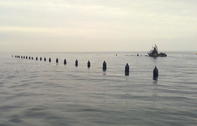Long-line culture has become the most common method used for farming oysters in South Africa. It is reported to have less environmental impact compared to other oyster production methods such as raft and rack culture.

In the oyster rack system, oyster bags are attached to racks fixed onto support structures, thus exposing oysters at low tide.
Spat - seed oysters or baby oysters - is imported from Chile, Europe, the US and Namibia, but some seed oysters are produced in Kleinzee in the Northern Cape. Seed oysters are grown out in offshore systems based in sheltered bays. Oysters filter-feed on plankton in the water, are regularly inspected and graded for size and after harvest, conditioned in tanks of fresh seawater before graded again, packed and shipped via a cold chain.
The majority of oyster production is undertaken in marine bays such as Nelson Mandela Bay near Port Elizabeth and Saldanha Bay on the West Coast. A small government-funded facility in the Keiskamma estuary is the only oyster farm in an estuary in South Africa. There are no oyster farms in the Knysna lagoon.
The Volume of Oyster Production
Worldwide annual production of Pacific oyster is around 660 000 tonnes. Production of oysters in South Africa has varied between 250 and 300 tonnes per year in the period between 2000 and 2013 and has stabilised at 500 tonnes in 2018. According to the Department of Agriculture, Forestry and Fisheries (DAFF) South Africa exported 67 tons of oysters in 2015 mainly to the Asian market including China, but also to African countries.
Much of global oyster production is consumed by local markets. Oysters are preferred fresh and live but are also available as half-shell. Canned, frozen and vacuum-packed oysters are also available.
Oyster Market in South Africa
Restaurants in South Africa are supplied live, locally produced oysters. The domestic market is seasonal, with more oysters consumed during the warmer months of November to April. Depending on the season, about 70% of South African oysters are destined for the domestic market and 30% for export, mainly to China and Hong Kong, says John Rice of the Knysna Oyster Company.
Sizing of oysters is based on a mix ranging from cocktail size 40 - 49 g, to extra large over 100 g. An approximate production ratio of whole oysters in their different size categories are below:
Cocktail
40 - 49 g - 5%
Champagne
50 - 59 g - 20%
Medium
60 - 69 g - 20%
70 - 79 g - 30%
Large
80 - 89 g - 7.5%
90 - 99 g - 8%
Extra-large
100 - 109 g - 5%
110 - 120 g - 5%
International prices for Pacific oysters depends on size grading, product form and demand, so prices vary. According to the Aquaculture Association of Southern Africa (AASA) no oysters are imported.
By Marinda Louw
For bulk or export enquiries please use the enquiry link below.